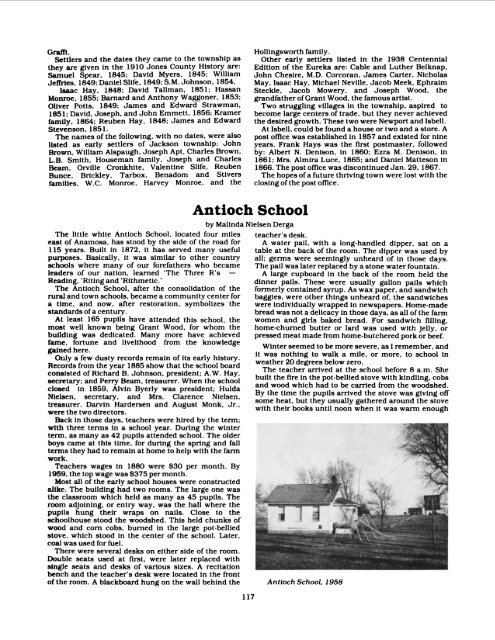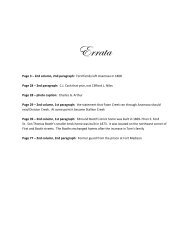Anamosa - A Reminiscence 1838 - 1988
The definitive history of the community of Anamosa, Iowa, USA
The definitive history of the community of Anamosa, Iowa, USA
Create successful ePaper yourself
Turn your PDF publications into a flip-book with our unique Google optimized e-Paper software.
Graift.<br />
Settlers and the dates they came to the township as<br />
they are given in the 1910 Jones County History are:<br />
Samuel Spear, 1845; David Myers, I845: William<br />
Jeffries, 1849; Daniel Slife, 1849; S.M. Johnson, 1854.<br />
Isaac I-lay, 1848; David Tallman. 1851; I-lassan<br />
Monroe, 1855; Barnard and Anthony Waggoner, 1853:<br />
Oliver Potts. 1849; James and Edward Strawman.<br />
I851: David, Joseph, and John Emmett, 1856; Kramer<br />
family, 1864; Reuben Hay. 1846; James and Edward<br />
Stevenson, 1851.<br />
The names of the following, with no dates, were also<br />
listed as early settlers of Jackson township: John<br />
Brown, William Aispaugh. Joseph Apt, Charles Brown.<br />
L.B. Smith, Houseman family, Joseph and Charles<br />
Beam. Orville Cronkhite, Valentine Slife, Reuben<br />
Bunce. Brlckley, Tarbox. Benadom and Stivers<br />
families, W.C. Monroe, Harvey Monroe, and the<br />
Hollingsworth family.<br />
Other early settlers listed in the I938 Centennial<br />
Edition of the Eureka are: Cable and Luther Belknap.<br />
John Chesire, M.D. Corcoran, James Carter, Nicholas<br />
May, Isaac Hay, Michael Neville, Jacob Meek, Ephraim<br />
Steckle. Jacob Mowery, and Joseph Wood, the<br />
grandfather ofGrant Wood, the famous artist.<br />
Two struggling villages in the township, aspired to<br />
become large centers of trade, but they never achieved<br />
the desired growth. These two were Newport and Isbell.<br />
At Isbell. could be found a house or two and a store. A<br />
post office was established in 1857 and existed for nine<br />
years. Frank Hays was the flrst postmaster, followed<br />
by: Albert N. Denison, in 1860; Ezra M. Denison, in<br />
1861: Mrs. Almira Luce, 1865; and Daniel Matteson in<br />
1866. The post office was discontinued Jan. 29, 1867.<br />
The hopes of a future thriving town were lost with the<br />
closing of the post oifice.<br />
The little white Antioch School. located four miles<br />
east of <strong>Anamosa</strong>, has stood by the side of the road for<br />
I15 years. Built in 1872, it has served many useful<br />
purposes. Basically, it was similar to other country<br />
schools where many of our forefathers who became<br />
leaders of our nation, learned ‘The Three R's —<br />
Reading, 'Riting and 'Rithmetic.'<br />
The Antioch School, after the consolidation of the<br />
rural and town schools. became a community center for<br />
a time, and now, after restoration, symbolizes the<br />
standards of a century.<br />
At least 165 pupils have attended this school, the<br />
most well known being Grant Wood, for whom the<br />
building was dedicated. Many more have achieved<br />
fame. fortune and livelihood from the knowledge<br />
gained here.<br />
Only a few dusty records remain of its early history.<br />
Records from the year I885 show that the school board<br />
consisted of Richard B. Johnson, president; A.W. Hay,<br />
secretary: and Perry Beam, treasurer. When the school<br />
closed in 1859, Alvin Byerly was president; Hulda<br />
Nielsen, secretary, and Mrs. Clarence Nielsen,<br />
treasurer. Darvin I-Iardersen and August Monk, Jr..<br />
were the two directors.<br />
Back in those days. teachers were hired by the term;<br />
with three terms in a school year. During the winter<br />
term. as many as 42 pupils attended school. The older<br />
boys came at this time, for during the spring and fall<br />
terms they had to remain at home to help with the farm<br />
work.<br />
Teachers wages in 1880 were S30 per month. By<br />
1959, the top wage was $375 per month.<br />
Most all of the early school houses were constructed<br />
alike. The building had two rooms. The large one was<br />
the classroom which held as many as 45 pupils. The<br />
room adjoining, or entry way, was the hall where the<br />
pupils hung their wraps on nails. Close to the<br />
schoolhouse stood the woodshed. This held chunks of<br />
wood and corn cobs, burned in the large pot-bellied<br />
stove. which stood in the center of the school. Later.<br />
coal was used for fuel.<br />
There were several desks on either side of the room.<br />
Double seats used at first, were later replaced with<br />
single seats and desks of various sizes. A recitation<br />
bench and the teacher's desk were located in the front<br />
of the room. A blackboard hung on the wall behind the<br />
Antioch School<br />
by Malinda Nielsen Derga<br />
117<br />
teacher's desk.<br />
A water pail, with a long-handled dipper, sat on a<br />
table at the back of the room. The dipper was used by<br />
all; germs were seemingly unheard of in those days.<br />
The pail was later replaced by a stone water fountain.<br />
A large cupboard in the back of the room held the<br />
dinner pails. These were usually gallon pails which<br />
formerly contained syrup. As wax paper, and sandwich<br />
baggies, were other things unheard of, the sandwiches<br />
were individually wrapped in newspapers. Home-made<br />
bread was not a delicacy in those days, as all of the farm<br />
women and girls baked bread. For sandwich filling.<br />
home-churned butter or lard was used with jelly, or<br />
pressed meat made from home-butchered pork or beef.<br />
Winter seemed to be more severe, as I remember. and<br />
it was nothing to walk a mile, or more, to school in<br />
weather 20 degrees below zero.<br />
The teacher arrived at the school before 8 a.m. She<br />
built the fire in the pot-bellied stove with kindling, cobs<br />
and wood which had to be carried from the woodshed.<br />
By the time the pupils anived the stove was giving off<br />
some heat, but they usually gathered around the stove<br />
with their books until noon when it was warm enough<br />
Antioch School, 1958<br />
Gnu“



